Western physical culture
Western physical culture is the form of physical culture that originated mainly in the West.
History[edit]
Ancient era[edit]
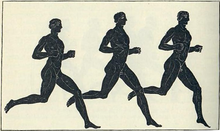
The practice of calisthenics by the ancient Greeks,[1] as well as the way in which sport was a major part of their society, as seen in events such as the Ancient Olympic Games and the way in which sport featured in domains such as poetry and religion,[2] served as a foundation for modern Western physical culture.[3]
Many current rural games in the West are believed to have originated as pagan practices from around the time of the ancient Greeks onward.[4]
Medieval era[edit]
The ancient Olympics came to an end around the late 5th century CE partially due to changing cultural tastes that were influenced by the uptake of Christianity throughout Europe, though broader claims that are often made of Christianity having been wholly responsible for the end of the ancient Olympics have been debunked.[5] Christians continued to practice sports during feast days, holy days and Sundays throughout the medieval era.[6] However, gymnasium cultures declined in Europe up until the Renaissance,[7][8] though the utilitarian war-oriented tradition of ancient Spartan and Roman training methods, which contrasted with the broader humanistic educational background that most ancient Greek physical cultural forms were offered in, remained relevant.[9]
Modern era[edit]

The physical culture movement in the United States during the 19th century owed its origins to several cultural trends.[11]
In the United States, German immigrants after 1848 introduced a physical culture system based on gymnastics that became popular especially in colleges. Many local Turner clubs introduced physical education (PE) in the form of 'German gymnastics' into American colleges and public schools. The perception of Turner as 'non-American' prevented the 'German system' from becoming the dominating form. They were especially important mainly in the cities with a large German-American population, but their influence slowly spread.[12]
By the late 19th century reformers worried that sedentary white collar workers were suffering from various "diseases of affluence" that were partially attributed to their increasingly sedentary lifestyles. In consequence, numerous exercise systems were developed, typically drawing from a range of traditional folk games, dances and sports, military training and medical calisthenics.
Physical culture programs were promoted through the education system, particularly at military academies, as well as via public and private gymnasiums.
Industry began the production of various items of exercise-oriented sports equipment. During the early and mid-19th century, these printed works and items of apparatus generally addressed exercise as a form of remedial physical therapy.
Certain items of equipment and types of exercise were common to several different physical culture systems, including exercises with Indian clubs, medicine balls, wooden or iron wands and dumbbells.
Combat sports such as fencing, boxing, savate and wrestling were also widely practiced in physical culture schools and were touted as forms of physical culture in their own right.
The Muscular Christianity movement of the late 19th century advocated a fusion of energetic Christian activism and rigorous physical culture training.Relationship with various movements[edit]
Christianity[edit]
Western physical culture experienced some suppression in the late medieval era as a result of Puritan sentiments. In early-19th century Britain, churches generally condemned sports as encouraging excessive violence and being associated with gambling.[13] Throughout the West, the majority of church-goers were women, with the feminine non- or anti-body qualities of Christianity having been more influential on society than masculine/physical qualities for centuries.[14] Western physical culture then received significant support due to the rise of Muscular Christianity.[15] However, the British practice of playing sports at church greatly declined in the aftermath of World War II.[13]
Militarism and imperialism[edit]
The battle of Waterloo was won on the playing fields of Eton.
In imperial Britain, the push for physical fitness coincided with the overall military needs of the British Empire,[17] with this push increasing as threats to the Empire emerged during its later period.[18][19] The push for physical fitness also acted to suggest that greater moral character could be found in physical fitness, and that white men had a racial purity and thus an obligation to be involved in empire.[20]
Throughout the early and middle 20th century, a greater usage of machinery in warfare made battlefields devoid of clumped-up masses of soldiers, which made individual soldiers more important, and increased the odds that soldiers had to brave in order to successfully kill enemies; in addition, industrialization, as well as a number of uniquely American factors, such as the closing of the frontier and corresponding urbanization, was seen as making men weak and "overcivilized".[14] In order to provide the moral, psychological and other types of strengthening that were seen as necessary in these circumstances, physical training was further emphasized in American military training of the time.[9]
Muscular religious nationalism[edit]

During the colonial era, Western ideas around masculinity, as well as the way in which accusations of effeminateness against Western colonial subjects were employed, encouraged the growth of muscular religious movements throughout the world.[21] With Muscular Christianity being a driving force behind Western physical culture and acting as a model for colonized peoples, movements such as Muscular Hinduism began in South Asia,[22][23][24] though figures such as Gandhi sought to counteract this by demonstrating strength and generosity without muscularity.[21] Some Jews, who had historically experienced millennia of discrimination within Europe, began to covet a kind of Muscular Judaism as a way to shake off what was argued by some to be the weakness of being in perpetual diaspora away from Israel.[25] Islam, whose adherents had been treated as overtly "feminine" during the colonial era, came to host fundamentalism and terrorist movements that attempted to pit the masculinities of Westerners and Muslims against each other during the post-colonial era. Pankaj Mishra has argued that the ethnic cleansing in Myanmar can be in some sense tied back to Anagarika Dharmapala and the creation of a new 'muscular Buddhism'.[21]
Nation-building and international community[edit]
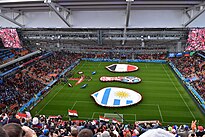
The spread of Western sports around the world, as well as the Western origins of international sporting ties, as seen through the history of events such as the Olympics, have helped in the formation of the modern community of nations.[27] The Commonwealth Games contributes to this aspect while building off of the way in which the legacy of Western imperialism brought various peoples together.[28]
Developing countries have often encouraged greater participation in Western sports in part to have greater relevance on the world stage.[29] Western sports have also served as part of the post-colonial nation-building process in many non-Western countries.[30][31][32]
Straight white male supremacy[edit]
Western physical culture sometimes intertwined with broader gender-, sexuality- and race-related conflicts, such as eugenics,[33] in Western countries.[34][35] Homosexual people were seen as to be reviled during the peak of European imperialism, at a time when there was a dispersal of messaging about the need to reclaim masculinity through muscularity and the execution of a "regenerative violence" throughout the world.[21] Women who succeeded in sports were often seen as less womanly, as fitting into a paradigm that centered around masculinity in sports.[36]
Within the United States, Western physical culture supplanted Native American ideas about physical culture, with Native American women in particular being historically seen as bound to be physically weak without white intervention.[37] In Canada, indigenous peoples sometimes used equestrian activities like rodeo to showcase their athletic prowess in relation to European settlers.[38]
Influence on the world[edit]
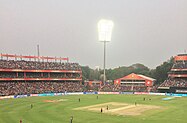
Western physical culture greatly influenced the world during and after the colonial era. The practice of colonialism itself was underpinned by Western ideas regarding masculine fitness or absence thereof throughout the world; for example, the British felt that many peoples of the world were physically unfit, and therefore incapable of governing themselves.[41][21]
Africa[edit]
The colonization of Africa resulted in a deep marginalization of traditional African games, with Western physical culture having been imposed to a significant extent. One reason for this was the imperial desire to stamp out militaristic training activities that had been prevalent among the native population.[42] Christian missionaries disseminated Western physical culture throughout Africa through the schooling systems, with the general belief that Western civilization should supplant the native culture because it was superior and more rational being a driving force;[43][44] local games were seen as primitive and immoral.[45]
African subjects were seen as having a natural strength greater than white men, but at the same time, white men's supposed superior physical discipline was used as a way of explaining Western dominance over Africa.[46] In South Africa, Western sports were simultaneously included within the purview of apartheid policies and a vector of demonstration for anti-apartheid sentiments and performances.[47]
Asia[edit]
Various Eastern martial arts which were earlier practiced as part of broader moral-philosophical systems became more akin to sporting/competitive activities with the advent of Western influences.[48]
East Asia[edit]
China[edit]
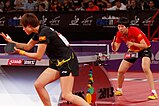
Western physical culture was brought into China with an initial element of Western military force backing its entry into Chinese society,[50] and was introduced during the 19th-century Qing dynasty in the form of military drills, Western-style schooling, and Christian missionary influences by organizations such as the YMCA.[51][52] The shock from the encounter with the West forced Chinese academics to debate the way in which the Western ideas surrounding physical culture should be adopted into Chinese society, with some calling for the end of "moribund" Chinese traditions.[53]
Western physical culture contrasted with and overtook native Chinese physical culture to a significant extent, with Western physical culture encouraging a greater level of competitiveness, whereas Chinese physical culture, influenced by anti-physical Confucian ideals,[54] emphasized internal cultivation of qi and the harmonious relationship between man and nature.[55][56] The introduction of the competitiveness and ideas of "fair play" present in the Western physical culture into China is argued to have served as a foundation for modern global capitalism in the country, as well as a transition enforced by the Chinese government to a more militaristic/nationalistic Chinese nation-state,[57][58] with sporting excellence in events such as the Olympics pursued as an ideal to unify China and present its rise on the world stage.[59][60]
Japan[edit]
Western physical culture's introduction into Japan occurred in a relatively haphazard way, with a variety of Western professors, military personnel, and others teaching various sports to the Japanese.[27]
South Asia[edit]
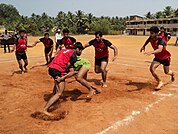
Modern yoga originated from the colonial-era interaction between Western physical culture and pre-existing forms of hatha yoga in India,[61][62] and grew as South Asians sought to combat British perceptions of Indian men as effeminate by fusing Western bodybuilding methodologies with indigenous traditions.[63][64] The formation and propagation of modern yoga has led to what some have argued as being the neglect of the non-bodily aspects of yoga.[65]
The YMCA was influential in introducing American ideas and certain standardizing influences into South Asian sports through the provincial governments.[66][67][68] The overall colonial-era interaction between India and the West also led to the growth of movements such as Muscular Hinduism.[69] Some South Asians played British sports as a form of anti-colonial resistance, by aiming to defeat their colonizers in these sports (with cricket in particular having continued in this role of creating a national platform for international competition in the post-colonial era.)[70][71] British sports also served in some contexts as a way to break down caste barriers among South Asians.[72][73]
Southeast Asia[edit]
In Laos, Western ideas around sport were introduced by applying Buddhist cultural conventions surrounding discipline and merit to physical fitness.[74]
West Asia[edit]
Influences from the non-West[edit]
Eastern martial arts have grown in the West, and are often considered as having sacred or spiritual implications beyond that of traditional Western physical culture.[75][76]
References[edit]
- ^ Hoffman, Jonathan; Gabel, C. Philip (2015-11-02). "The origins of Western mind–body exercise methods". Physical Therapy Reviews. 20 (5–6): 315–324. doi:10.1080/10833196.2015.1125587. PMC 5022134. PMID 27695277.
- ^ The Allure of Sports in Western Culture. University of Toronto Press. 2019. ISBN 978-1-4875-0418-2. JSTOR 10.3138/j.ctvpmw44f.
- ^ Harmandar, Duygu; Yildiran, Ibrahim (15 October 2013). "The Philosophy of Physical Education and Sport from Ancient Times to the Enlightenment". European Journal of Educational Research. 2 (4): 191–202. doi:10.12973/eu-jer.2.4.191. ERIC EJ1086323.
- ^ UNESCO (2008-12-31). History of Humanity: The Twentieth Century. UNESCO Publishing. ISBN 978-92-3-104083-2.
- ^ Magazine, Smithsonian; Gabriele, David M. Perry,Matthew. "What the Medieval Olympics Looked Like". Smithsonian Magazine. Retrieved 2024-03-19.
{{cite web}}: CS1 maint: multiple names: authors list (link) - ^ Kelly, Patrick; Kelly, Patrick Michael (2012). Catholic Perspectives on Sports: From Medieval to Modern Times. Paulist Press. ISBN 978-0-8091-4795-3.
- ^ Heffernan, Conor (2022-12-15). The History of Physical Culture. Common Ground Research Networks. ISBN 978-1-957792-23-1.
- ^ McClelland, John (2007). Body and Mind. doi:10.4324/9780203967737. ISBN 978-1-135-77324-3.[page needed]
- ^ a b Gatzemeyer, Garrett (2021-11-05). Bodies for Battle: US Army Physical Culture and Systematic Training, 1885-1957. University Press of Kansas. ISBN 978-0-7006-3258-9.
- ^ Conrad, Sebastian (March 2021). "Globalizing the Beautiful Body: Eugen Sandow, Bodybuilding, and the Ideal of Muscular Manliness at the Turn of the Twentieth Century". Journal of World History. 32 (1): 95–126. doi:10.1353/jwh.2021.0005. Gale A655088504.
- ^ Shelly McKenzie, Getting Physical: The Rise of Fitness Culture in America (University Press of Kansas; 2013)
- ^ Gertrud Pfister, "The Role of German Turners in American Physical Education," International Journal of the History of Sport (2009) 26#13 pp 1893-1925.
- ^ a b McLeod, Hugh (2023-03-01). "How sport became the new religion – a 200-year story of society's 'great conversion'". The Conversation. Retrieved 2024-03-19.
- ^ a b McKay, Brett and Kate (2016-09-13). "When Christianity Was Muscular". The Art of Manliness. Retrieved 2024-03-22.
- ^ Watson, Nick J.; Parker, Andrew (2013). "Sports and Christianity: Mapping the Field". In Watson, Nick J.; Parker, Andrew (eds.). Sports and Christianity: Historical and Contemporary Perspectives. Routledge. pp. 9–88. ISBN 978-0-415-89922-2.
- ^ Gullace, Nicoletta F. (2015). "Review of "The Army Isn't All Work": Physical Culture and the Evolution of the British Army, 1860–1920". Victorian Studies. 57 (4): 727–729. doi:10.2979/victorianstudies.57.4.21. JSTOR 10.2979/victorianstudies.57.4.21.
- ^ Cleophas, F. J.; Van der Merwe, FJG (2009). "Physical education and physical culture in the coloured community of the Western Cape: Areview". African Journal for Physical Activity and Health Sciences. 15 (1). hdl:10520/EJC19564.
- ^ Zweiniger-Bargielowska, Ina (2010). "The Fit Male Body, Nation, and Empire". Managing the Body. pp. 62–104. doi:10.1093/acprof:oso/9780199280520.003.0003. ISBN 978-0-19-928052-0.
- ^ Budd, Michael Anton (1997). "Imperial Mirrors". The Sculpture Machine. pp. 81–100. doi:10.1057/9780230377127_5. ISBN 978-1-349-39337-4.
- ^ Chow, Broderick D. V. (3 September 2015). "A Professional Body: Remembering, repeating and working out masculinities in fin-de-siècle physical culture". Performance Research. 20 (5): 30–41. doi:10.1080/13528165.2015.1095910.
- ^ a b c d e f Mishra, Pankaj (2018-03-17). "The crisis in modern masculinity". The Guardian. ISSN 0261-3077. Retrieved 2024-03-21.
- ^ Fletcher, Ian Christopher (2003). "Review of Ornamentalism: How the British Saw Their Empire". Victorian Studies. 45 (3): 532–534. ISSN 0042-5222. JSTOR 3830190.
- ^ Pringnitz, Keelin (2023-04-04). Shame, Modesty, Identity: Lived Religion In Athletic Spaces (Thesis thesis). Université d'Ottawa / University of Ottawa.
- ^ "The emergence of modern Hinduism: religion on the margins of colonialism". Library of Congress, Washington, D.C. 20540 USA. Retrieved 2024-02-17.
- ^ Zimmermann, Moshe (2006). "Muscle Jews versus Nervous Jews". In Brenner, Michael; Reuveni, Gideon (eds.). Emancipation through Muscles: Jews and sports in Europe. Lincoln, NE: University of Nebraska Press. p. 13. ISBN 0803213557. OCLC 0803213557.
- ^ Rofe, J. Simon (2022). "Diplomacy, International Relations, Soft Power and the FIFA World Cup". The Business of the FIFA World Cup. pp. 61–72. doi:10.4324/9781003121794-5. ISBN 978-1-003-12179-4.
- ^ a b Reischauer, Edwin O. "A UNION OF TWO WORLDS". Sports Illustrated Vault | SI.com. Retrieved 2024-03-20.
- ^ Kobierecki, Michał Marcin (March 2017). "The Commonwealth Games as an Example of Bringing States Closer Through Sport". Physical Culture and Sport. Studies and Research. 73 (1): 36–43. doi:10.1515/pcssr-2017-0004.
- ^ Riordan, Jim (December 1986). "State and Sport in Developing Societies". International Review for the Sociology of Sport. 21 (4): 287–303. doi:10.1177/101269028602100403.
- ^ Kang, Joon-Mann (January 1988). "Sports, media and cultural dependency". Journal of Contemporary Asia. 18 (4): 430–443. doi:10.1080/00472338880000321.
- ^ Darnell, Simon C.; Field, Russell; Kidd, Bruce (2019). "Anti-Colonialism and the Decolonization of Sport Development". The History and Politics of Sport-for-Development. pp. 125–159. doi:10.1057/978-1-137-43944-4_5. ISBN 978-1-137-43943-7. S2CID 159173362.
- ^ Morgan, William J. (May 1999). "Patriotic Sports and the Moral Making of Nations". Journal of the Philosophy of Sport. 26 (1): 50–67. doi:10.1080/00948705.1999.9714578.
- ^ Stieglitz, Olaf (2019). "'Mentally superior children are born of physically superior people': Bernarr Macfadden's 'Physical Culture' World and the Influence of Eugenic Thought in American Fitness Culture, 1900S-1930S". Amerikastudien / American Studies. 64 (2): 241–264. doi:10.33675/AMST/2019/2/7. JSTOR 45390291.
- ^ Heffernan, Connor (January 2022). "State of the Field: Physical Culture". History. 107 (374): 143–162. doi:10.1111/1468-229X.13258.
- ^ Schrank, Sarah (2014). "American Yoga: The Shaping of Modern Body Culture in the United States". American Studies. 53 (1): 169–181. doi:10.1353/ams.2014.0021. Project MUSE 545718.
- ^ Mathur, Nameeta (2001). Women and physical culture in modern Poland (Thesis). doi:10.33915/etd.1439. OCLC 48769301.[page needed]
- ^ Eby, Beth (2019). Building bodies, (un)making empire: gender, sport, and colonialism in the United States, 1880-1930 (Thesis). hdl:2142/105606.[page needed]
- ^ Kossuth, Robert (July 2019). "Indigenous and Colonial Physical Culture in Lethbridge: Sport, Contact, and Settlement on the Prairie Frontier". Journal of Sport History. 46 (2): 255–272. doi:10.5406/jsporthistory.46.2.0255.
- ^ Aripaka, Rahul (2023-04-30). "IPL: How India became home to the biggest, baddest cricketing league in the world". The Economic Times. Retrieved 2024-03-18.
- ^ a b Love, Adam; Dzikus, Lars (2020-02-26). "How India came to love cricket, favored sport of its colonial British rulers". The Conversation. Retrieved 2024-03-18.
- ^ Cleophas, Francois Johannes (2021-04-08). Critical Reflections on Physical Culture at the Edges of Empire. African Sun Media. ISBN 978-1-928480-69-3.
- ^ Nauright, John; Amara, Mahfoud (2018-05-16). Sport in the African World. Routledge. ISBN 978-1-351-21273-1.
- ^ Saayman, Willem (1991). "'Who Owns the Schools Will Own Africa' Christian Mission, Education and Culture in Africa". Journal for the Study of Religion. 4 (2): 29–44. JSTOR 24764244.
- ^ Mubita, Akatama (December 2017). "A History of Physical Education in Zambia". Physical Culture and Sport. Studies and Research. 76 (1): 47–54. doi:10.1515/pcssr-2017-0029.
- ^ Amusa, L. O.; Toriola, A. L. (2010). "The changing phases of Physical education in Africa: Can a uniquely African model emerge?". African Journal for Physical Activity and Health Sciences. 16 (4).
- ^ Budd, Michael Anton (1997). The Sculpture Machine: Physical Culture and Body Politics in the Age of Empire. NYU Press. ISBN 978-0-8147-1267-2.
- ^ Cleophas, Francois Johannes (2021-04-08). Critical Reflections on Physical Culture at the Edges of Empire. African Sun Media. ISBN 978-1-928480-68-6.
- ^ Channon, Alex (August 2012). "Western men and Eastern arts: The significance of Eastern martial arts disciplines in British men's narratives of masculinity". Asia Pacific Journal of Sport and Social Science. 1 (2–3): 111–127. doi:10.1080/21640599.2012.751170.
- ^ "Once a tool for diplomacy, table tennis now viewed by China as so much more". NBC News. 2021-08-06. Retrieved 2024-03-18.
- ^ Hong, Fan; Hua, Tan (July 2002). "Sport in China: Conflict between Tradition and Modernity, 1840s to 1930s". The International Journal of the History of Sport. 19 (2–3): 189–212. doi:10.1080/714001756.
- ^ Jarvie, Grant; Hwang, Dong-Jhy; Brennan, Mel (2008-05-15). Sport, Revolution and the Beijing Olympics. Berg. ISBN 978-1-84520-101-2.
- ^ Zhang, Huijie; Hong, Fan; Huang, Fuhua (2017). "Missionary schools, the YMCA and the modernization of Chinese sport". Christianity and the Transformation of Physical Education and Sport in China. pp. 109–119. doi:10.4324/9781315210766-6. ISBN 978-1-315-21076-6.
- ^ Brownell, Susan (1995). Training the Body for China: Sports in the Moral Order of the People's Republic. University of Chicago Press. ISBN 978-0-226-07646-1.
- ^ Bairner, Alan (June 2011). "The Confucian legacy and its implications for physical education in Taiwan". European Physical Education Review. 17 (2): 219–230. doi:10.1177/1356336X11413169.
- ^ Tang (湯志傑), Chih-Chieh. "Yundong One Term for Two Different Body Cultures". The First International Conference for the Sociology of Sport, Taiwan (Taoyuan : National Taiwan Sport University & the Taiwan Society of Sport Sociology).
- ^ Ng, Pei-San (2016). Strength From Within: the Chinese Internal Martial Arts as Discourse, Aesthetics, and Cultural Trope (1850–1940) (Thesis). ProQuest 1916572523.[page needed]
- ^ Morris, Andrew D. (2004). Marrow of the Nation: A History of Sport and Physical Culture in Republican China. University of California Press. ISBN 978-0-520-24084-1.[page needed]
- ^ Hwang, Dong-Jhy; Chang, Li-Ke (2008). "Sport, Maoism and the Beijing Olympics: One Century One Ideology". China Perspectives. 2008 (1): 4–17. doi:10.4000/chinaperspectives.3223.
- ^ Zhang, Huijie (2015). Missionary schools, the YMCA and the transformation of physical education and sport in modern China (1840-1937) (PDF) (Thesis). S2CID 134272454.[page needed]
- ^ Morris, Andrew (October 2000). "'To Make the Four Hundred Million Move': The Late Qing Dynasty Origins of Modern Chinese Sport and Physical Culture". Comparative Studies in Society and History. 42 (4): 876–906. doi:10.1017/S0010417500003340.
- ^ Foxen, Anya P. (2020). Inhaling Spirit. doi:10.1093/oso/9780190082734.001.0001. ISBN 978-0-19-008273-4.[page needed]
- ^ Singleton, Mark (2010). "India and the International Physical Culture Movement". Yoga Body. pp. 81–94. doi:10.1093/acprof:oso/9780195395358.003.0005. ISBN 978-0-19-539535-8.
- ^ "A Brief History of Modern Yoga". TheCollector. 2022-07-05. Retrieved 2024-03-18.
- ^ Singleton, Mark (2010). "Modern Indian Physical Culture: Degeneracy and Experimentation". Yoga Body. pp. 95–112. doi:10.1093/acprof:oso/9780195395358.003.0006. ISBN 978-0-19-539535-8.
- ^ McKibben, Elizabeth (4 February 2024). "Mind-Stuff and Withdrawal of the Senses: Toward an Interpretation of Pratyahara in Contemporary Postural Yoga". Health: An Interdisciplinary Journal for the Social Study of Health, Illness and Medicine. doi:10.1177/13634593231222450. PMID 38311913.
- ^ Fischer-Tiné, Harald (March 2019). "Fitness for Modernity? The YMCA and physical-education schemes in late-colonial South Asia (circa 1900–40)". Modern Asian Studies. 53 (2): 512–559. doi:10.1017/S0026749X17000300.
- ^ Ramachandran, Aishwarya (2019). Counterflows of knowledge : the transnational circulation of physical culture practices between India and the West during the early 20th century (Thesis). University of British Columbia.
- ^ Watt, Carey (2021). "Physical culture and the body in colonial India, c.1800–1947". Routledge Handbook of the History of Colonialism in South Asia. pp. 345–358. doi:10.4324/9780429431012-33. ISBN 978-0-429-43101-2.
- ^ Baier, Karl. Modern Yoga Research (Report).
After his stay in the United States, Vivekananda promoted the importance of building up physical strength for the spiritual development of Hindus.
[self-published source?] - ^ Mills, James; Dimeo, Paul (2020). "'When Gold is Fired It Shines': Sport, the Imagination and the Body in Colonial and Postcolonial India". Sport and Postcolonialsm. pp. 107–122. doi:10.4324/9781003086772-8. ISBN 978-1-003-08677-2.
- ^ Maddox, Callie Elizabeth (2012). Postcolonial play: Encounters with sport and physical culture in contemporary India (Thesis). ProQuest 1314798814.[page needed]
- ^ "Muscular Christianity in Colonial and Post-Colonial Worlds". Reviews in History. Retrieved 2024-03-19.
- ^ "'The Revenge of Plassey': Football in the British Raj". LSE International History. 2020-07-20. Retrieved 2024-03-19.[self-published source?]
- ^ Creak, Simon (2011). "Muscular Buddhism for Modernizing Laos" (PDF). The Journal of Lao Studies. 2 (2): 1–22. S2CID 165122180.
- ^ Camorrino, Antonio (27 September 2018). "Green Spirituality and Physical Culture. Extreme Sports and the Imagery of Wilderness". Societies. 8 (4): 96. doi:10.3390/soc8040096.
- ^ Channon, Alex (August 2012). "Western men and Eastern arts: The significance of Eastern martial arts disciplines in British men's narratives of masculinity". Asia Pacific Journal of Sport and Social Science. 1 (2–3): 111–127. doi:10.1080/21640599.2012.751170.
